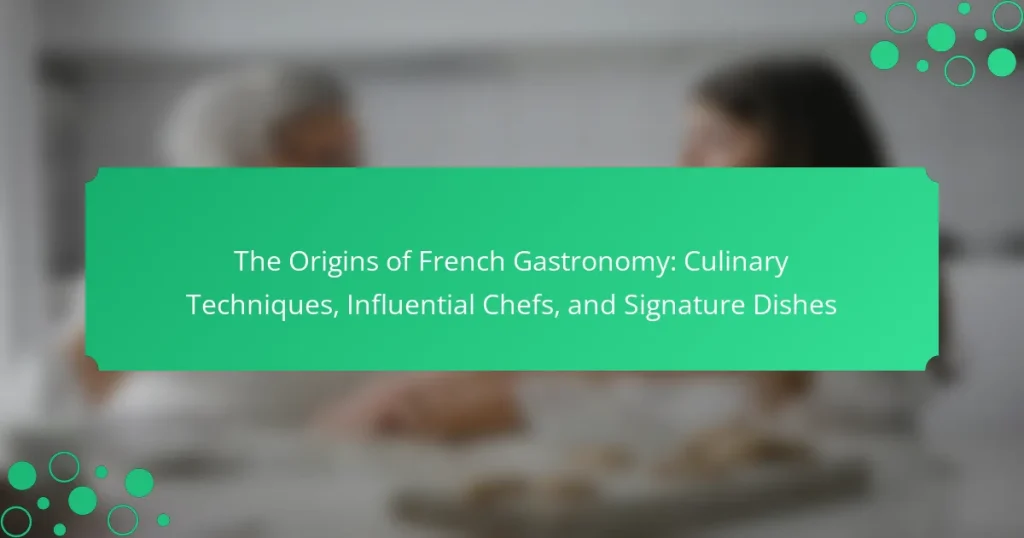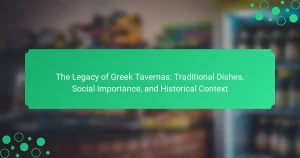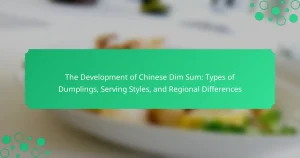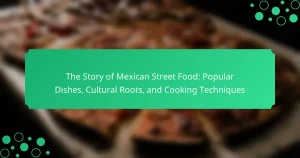French gastronomy is a rich culinary tradition that has evolved since the Middle Ages, shaped by regional ingredients and cooking methods. Key historical figures such as Taillevent and Auguste Escoffier have established foundational culinary techniques, including sautéing, poaching, and braising, which are essential for flavor development. Signature dishes like Coq au Vin, Bouillabaisse, and Ratatouille exemplify the diverse flavors of French cuisine. The democratization of cooking knowledge following the French Revolution and the recognition of French cuisine by UNESCO in 2010 highlight its cultural significance and global influence. Influential chefs, including Paul Bocuse and Julia Child, have further popularized French culinary arts, making it a benchmark in the world of gastronomy.
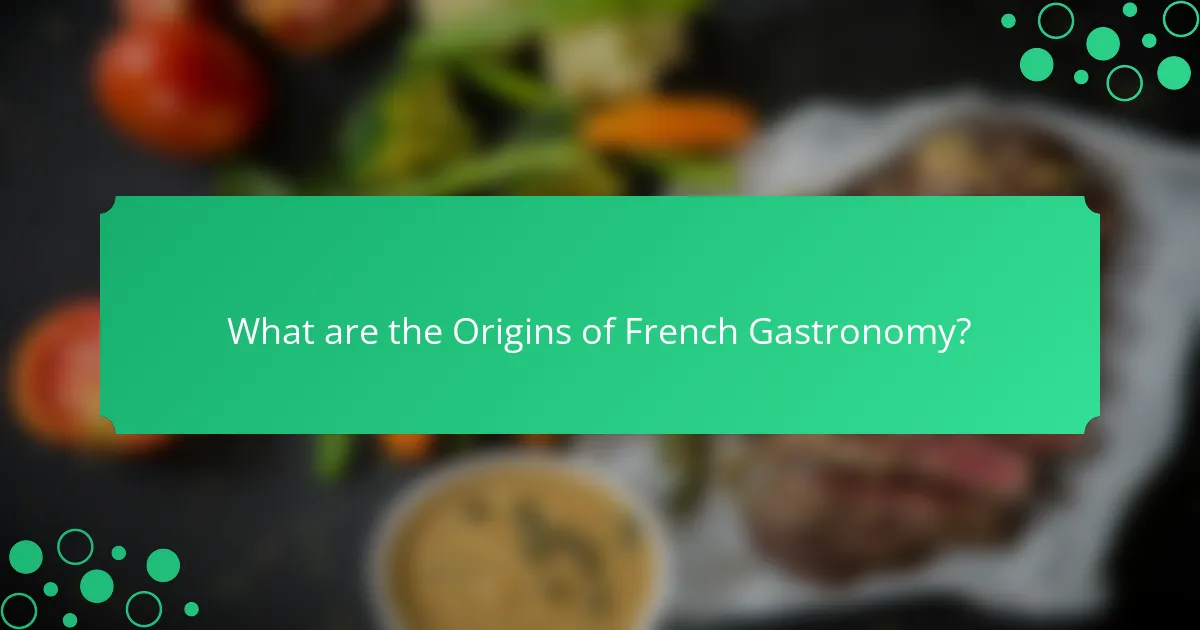
What are the Origins of French Gastronomy?
French gastronomy originated in the Middle Ages, influenced by regional ingredients and cooking methods. The establishment of culinary traditions began with the use of herbs and spices from trade routes. The Renaissance period further refined these practices, introducing new techniques and dishes. Notable chefs like Taillevent and later Escoffier shaped French culinary standards. The French Revolution democratized cuisine, allowing broader access to cooking knowledge. This evolution positioned French gastronomy as a global benchmark for culinary arts. The recognition of French cuisine by UNESCO in 2010 underscored its cultural significance.
How did French Gastronomy evolve over time?
French gastronomy evolved significantly from the Middle Ages to modern times. Initially, it was influenced by medieval cooking styles that emphasized heavy sauces and spicing. The Renaissance brought new ingredients and techniques from Italy, leading to lighter dishes. In the 17th century, chefs like François Vatel began to refine culinary techniques, emphasizing presentation and flavor balance. The 19th century saw the emergence of haute cuisine, characterized by elaborate meals and meticulous preparation. Auguste Escoffier further revolutionized French cuisine by organizing kitchens and creating a system of culinary classification. The 20th century introduced nouvelle cuisine, focusing on fresh ingredients and simplicity. Today, French gastronomy continues to evolve, incorporating global influences while maintaining its rich traditions.
What historical events influenced the development of French Culinary Arts?
The development of French Culinary Arts was significantly influenced by the Renaissance, the French Revolution, and the establishment of culinary schools. The Renaissance brought new ingredients and techniques from Italy. This period emphasized the importance of presentation and flavor in cooking. The French Revolution led to the rise of professional chefs and the democratization of cuisine. It marked a shift from royal kitchens to public dining establishments. The establishment of culinary schools, such as Le Cordon Bleu in 1895, formalized culinary education. These schools trained chefs in classical techniques and modern practices. These historical events collectively shaped the rich tradition of French cuisine.
How did regional variations shape French Gastronomy?
Regional variations significantly shaped French gastronomy by introducing diverse ingredients and cooking techniques. Each region of France boasts unique culinary traditions, influenced by local agriculture and climate. For example, Provence is known for its use of herbs and olive oil, while Normandy features dairy and apple-based dishes. The mountainous regions offer hearty fare, utilizing game and root vegetables. Coastal areas emphasize seafood, reflecting the availability of fresh fish. Historical trade routes also fostered the exchange of spices and flavors, enriching regional cuisines. This regional diversity is evident in iconic dishes like bouillabaisse from Marseille and coq au vin from Burgundy. The interplay of these factors created a rich tapestry of flavors that defines French gastronomy today.
Why is French Gastronomy considered a cornerstone of culinary arts?
French gastronomy is considered a cornerstone of culinary arts due to its historical influence and refined techniques. It has shaped modern cooking practices worldwide. French cuisine emphasizes the importance of technique, presentation, and flavor balance. Classic methods such as sautéing, poaching, and braising originated from French culinary traditions. The development of culinary schools in France, like Le Cordon Bleu, has further institutionalized these techniques. Influential chefs, such as Auguste Escoffier, standardized recipes and menus, elevating the profession. French gastronomy also introduced the concept of haute cuisine, which focuses on high-quality ingredients and elaborate presentation. UNESCO recognized French gastronomy as an intangible cultural heritage in 2010, highlighting its global significance.
What principles define French culinary techniques?
French culinary techniques are defined by precision, technique, and the use of high-quality ingredients. These principles emphasize the importance of mastering basic techniques, such as sautéing, poaching, and braising. French cuisine values the balance of flavors and textures in each dish. It also incorporates the art of presentation, making food visually appealing. Additionally, the use of sauces is a hallmark of French cooking, enhancing dishes with complex flavors. The techniques often reflect regional ingredients and traditions. Classic French cooking techniques serve as a foundation for many global cuisines. These principles have been codified in culinary schools and cookbooks, ensuring their preservation and transmission.
How has French Gastronomy influenced global cooking practices?
French gastronomy has significantly influenced global cooking practices through its techniques and principles. The emphasis on technique, such as sautéing and braising, has become foundational in many cuisines. French culinary schools have trained chefs worldwide, spreading these methods. The use of sauces, a hallmark of French cuisine, has inspired countless dishes globally. Additionally, the concept of fine dining and presentation originated in France, shaping restaurant culture worldwide. Influential chefs like Auguste Escoffier formalized culinary arts, establishing standards still used today. French cuisine also introduced the idea of regional specialties, which encouraged local sourcing in other cultures. Overall, French gastronomy’s structured approach and rich flavors continue to resonate in kitchens around the world.

What Culinary Techniques are Essential to French Gastronomy?
Essential culinary techniques in French gastronomy include sautéing, poaching, and braising. Sautéing involves cooking food quickly in a small amount of fat over high heat. Poaching gently cooks food in simmering liquid, preserving moisture and flavor. Braising combines both dry and wet cooking methods, starting with searing followed by slow cooking in liquid. These techniques are foundational in French cuisine, allowing for the development of rich flavors and textures. Historical texts, such as “Le Guide Culinaire” by Auguste Escoffier, emphasize these methods as crucial for mastering French cooking.
What are the foundational cooking methods in French cuisine?
The foundational cooking methods in French cuisine include sautéing, poaching, roasting, and braising. Sautéing involves cooking food quickly in a small amount of fat over high heat. Poaching is a gentle cooking method where food is submerged in a simmering liquid. Roasting typically involves cooking food evenly in an oven, often resulting in a browned exterior. Braising combines both moist and dry heat, cooking food slowly in a small amount of liquid. These methods are essential in French gastronomy, influencing countless dishes and techniques.
How do techniques like sautéing and braising differ?
Sautéing and braising are distinct cooking techniques. Sautéing involves cooking food quickly in a small amount of oil or fat over high heat. This method is ideal for vegetables and tender cuts of meat, resulting in a browned exterior and a moist interior.
Braising, on the other hand, is a slow cooking method that combines both dry and moist heat. It typically involves browning the food first, followed by cooking it in liquid at low temperatures for an extended period. This technique is best for tougher cuts of meat, making them tender and flavorful.
The primary difference lies in the cooking duration and moisture level. Sautéing is fast and uses minimal liquid, while braising is slow and uses significant liquid. These techniques serve different culinary purposes and yield varying textures and flavors in the final dish.
What role do sauces play in French cooking techniques?
Sauces are fundamental in French cooking techniques. They enhance flavors and provide moisture to dishes. French cuisine categorizes sauces into five mother sauces: béchamel, velouté, espagnole, hollandaise, and tomato. Each mother sauce serves as a base for numerous derivative sauces. Techniques such as emulsification and reduction are critical in sauce preparation. These methods concentrate flavors and improve texture. Sauces also reflect regional ingredients and culinary traditions. Mastery of sauces is essential for aspiring chefs in French gastronomy.
How do modern culinary techniques integrate with traditional French methods?
Modern culinary techniques integrate with traditional French methods through innovation and technology. Sous-vide cooking exemplifies this integration. This method allows precise temperature control, enhancing the flavors of classic French dishes. Molecular gastronomy also plays a role. It involves scientific principles to create new textures and flavors while respecting traditional recipes.
Chefs like Ferran Adrià and Heston Blumenthal have pioneered this fusion. They apply techniques like spherification and emulsification to classic French sauces and desserts. Additionally, the use of modern equipment, such as blowtorches and immersion circulators, elevates traditional cooking methods.
The result is a contemporary approach that maintains the essence of French cuisine while embracing new possibilities. This blend preserves culinary heritage while pushing creative boundaries.
What innovations have emerged in contemporary French cuisine?
Contemporary French cuisine has seen innovations such as molecular gastronomy, which uses scientific techniques to enhance flavors and textures. Chefs like Pierre Gagnaire and Ferran Adrià have popularized this approach. Another innovation is the focus on local and seasonal ingredients, emphasizing sustainability. This trend aligns with the farm-to-table movement, which has gained traction in recent years. Additionally, the fusion of global flavors into traditional French dishes has emerged, creating unique culinary experiences. For instance, Asian influences are increasingly incorporated into classic recipes. These innovations reflect a dynamic evolution in French culinary practices, showcasing creativity and adaptability.
How do chefs balance tradition and innovation in their cooking?
Chefs balance tradition and innovation by integrating classical techniques with modern culinary trends. They often start with foundational recipes that represent traditional cuisine. Chefs then experiment with new ingredients and presentation styles. This approach allows them to honor their culinary heritage while appealing to contemporary tastes. For instance, many chefs use sous-vide cooking, a modern technique, to enhance traditional dishes. By doing so, they maintain flavors while improving texture. The blending of old and new creates unique dining experiences. This practice reflects the evolving nature of gastronomy.
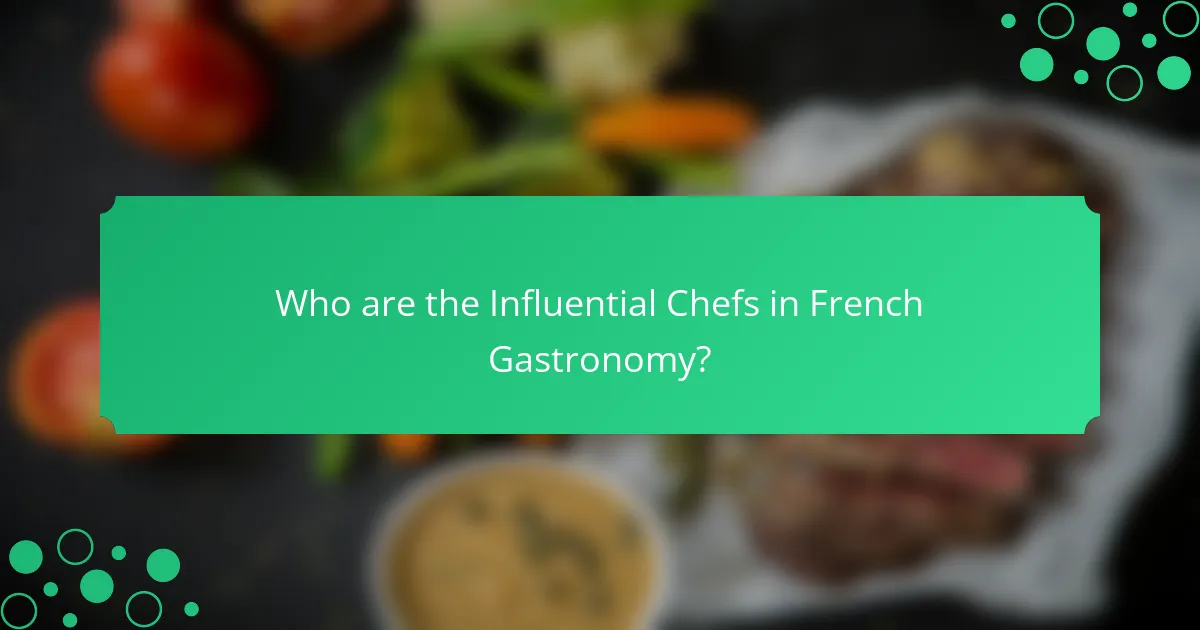
Who are the Influential Chefs in French Gastronomy?
Auguste Escoffier is a key figure in French gastronomy. He is known for modernizing French cuisine and introducing the brigade system in kitchens. Paul Bocuse is another influential chef, recognized for his role in popularizing nouvelle cuisine. Julia Child brought French cooking to American audiences, greatly impacting culinary education. Alain Ducasse is renowned for his innovative approach and multiple Michelin stars. Michel Guérard is noted for his health-conscious cuisine, blending traditional and modern techniques. These chefs have significantly shaped the landscape of French gastronomy through their contributions and culinary philosophies.
What impact did classic chefs have on French culinary traditions?
Classic chefs significantly shaped French culinary traditions. They established foundational techniques that are still used today. Chefs like Auguste Escoffier modernized cooking methods and created the brigade system. This system organized kitchen staff for efficiency and productivity. Classic chefs also emphasized the importance of sauces, which became central to French cuisine. Their focus on presentation elevated the dining experience to an art form. Furthermore, they introduced the concept of haute cuisine, which set standards for fine dining. The impact of these chefs is evident in the global influence of French gastronomy. Their legacy continues to inspire chefs worldwide.
How did chefs like Auguste Escoffier shape modern French cuisine?
Chefs like Auguste Escoffier significantly shaped modern French cuisine through their innovative techniques and structured approach. Escoffier introduced the concept of organizing kitchen staff into specific roles, which streamlined food preparation. He emphasized the importance of fresh ingredients and seasonal cooking, influencing contemporary culinary practices. Escoffier also developed the “haute cuisine” style, focusing on elaborate presentation and rich flavors. His publication, “Le Guide Culinaire,” became a foundational text for culinary education. This book codified classic French recipes and techniques, establishing a standard for professional chefs. Escoffier’s influence is evident in modern French cuisine’s emphasis on precision and artistry. His legacy continues to inspire chefs worldwide today.
What contributions did Julia Child make to French cooking in America?
Julia Child significantly popularized French cooking in America. She introduced French culinary techniques through her television show, “The French Chef,” which aired in 1963. This program made French cooking accessible to the American public. Child authored the influential cookbook “Mastering the Art of French Cooking,” published in 1961. This book provided detailed recipes and techniques for home cooks. Her emphasis on the importance of using quality ingredients elevated American cooking standards. Child’s approachable teaching style encouraged many to try French cuisine. She also contributed to the establishment of culinary schools in the U.S., enhancing professional training in French cooking. Overall, Child’s efforts transformed American perceptions of French cuisine and inspired a generation of chefs and home cooks alike.
Which contemporary chefs are redefining French Gastronomy today?
Alain Passard, Pierre Gagnaire, and Anne-Sophie Pic are contemporary chefs redefining French gastronomy today. Alain Passard is known for his vegetable-centric cuisine at L’Arpège. His focus on seasonal produce has transformed traditional French cooking. Pierre Gagnaire emphasizes creativity and innovation in his dishes. He blends classic techniques with modern flavors at his eponymous restaurant. Anne-Sophie Pic is celebrated for her unique flavor combinations. She is the only female chef in France with three Michelin stars. These chefs are pushing boundaries and elevating French cuisine globally. Their contributions reflect a modern interpretation of classic French gastronomy.
What are the signature styles of modern French chefs?
Modern French chefs often emphasize creativity, seasonal ingredients, and precision in their cooking. They frequently blend traditional techniques with contemporary presentations. This fusion results in visually stunning dishes that highlight flavors. Chefs like Alain Ducasse and Pierre Gagnaire exemplify this style. They focus on the purity of ingredients. Many modern chefs also incorporate global influences into their menus. This approach reflects the evolving nature of French cuisine. The use of molecular gastronomy is another hallmark of some modern chefs. This technique allows for innovative textures and flavors.
How do these chefs incorporate global influences into their work?
Chefs incorporate global influences into their work by integrating diverse ingredients and techniques from various cultures. They often experiment with spices and flavors from different regions. These chefs may adopt cooking methods like grilling, steaming, or fermenting from international cuisines. Fusion dishes are created by blending traditional French recipes with elements from Asian, African, or Latin American cooking. Seasonal and local produce is frequently combined with global flavors to enhance authenticity. Additionally, chefs may travel and study international culinary traditions, which informs their unique approaches. For instance, the use of miso in sauces or the incorporation of sushi elements into appetizers showcases this global integration. This practice not only enriches their dishes but also reflects a broader culinary landscape.

What are the Signature Dishes of French Gastronomy?
Signature dishes of French gastronomy include Coq au Vin, Bouillabaisse, and Ratatouille. Coq au Vin is a chicken dish braised with wine, lardons, and mushrooms. Bouillabaisse is a traditional Provençal fish stew made with various fish and aromatic herbs. Ratatouille is a vegetable dish consisting of eggplant, zucchini, and tomatoes, typically served as a side. Other notable dishes are Tarte Tatin, a caramelized upside-down apple tart, and Quiche Lorraine, a savory pie filled with eggs, cream, and bacon. These dishes reflect the diverse regional flavors and culinary techniques that characterize French cuisine.
What are the most iconic dishes in French cuisine?
The most iconic dishes in French cuisine include Coq au Vin, Bouillabaisse, and Ratatouille. Coq au Vin is a traditional dish made of chicken braised with wine, lardons, mushrooms, and garlic. This dish has roots in the Burgundy region and showcases the importance of wine in French cooking. Bouillabaisse is a fish stew originating from the port city of Marseille. It combines various fish and shellfish with aromatic herbs and spices, reflecting the coastal culinary traditions. Ratatouille is a vegetable dish that features eggplant, zucchini, bell peppers, and tomatoes. It represents the rustic cooking style of Provence. Other notable dishes include Tarte Tatin, a caramelized upside-down apple tart, and Crêpes, thin pancakes that can be filled with sweet or savory ingredients. These dishes exemplify the diverse flavors and techniques that define French gastronomy.
How do dishes like Coq au Vin and Bouillabaisse reflect regional flavors?
Coq au Vin and Bouillabaisse reflect regional flavors through their use of local ingredients and traditional cooking methods. Coq au Vin originates from Burgundy, utilizing red wine, mushrooms, and lardons typical of the region. This dish showcases the importance of wine in Burgundian cuisine. Bouillabaisse, hailing from Provence, features fresh fish, shellfish, and aromatic herbs like saffron and fennel. These ingredients highlight the Mediterranean influence on Provençal cooking. Both dishes embody the cultural essence of their regions, illustrating how geography shapes culinary traditions.
What ingredients are essential for creating classic French dishes?
Essential ingredients for creating classic French dishes include butter, cream, garlic, onions, and herbs. Butter is fundamental for sauces and cooking techniques. Cream adds richness to many dishes, such as sauces and desserts. Garlic and onions provide depth of flavor in various recipes. Fresh herbs like thyme, parsley, and tarragon enhance the taste of classic French cuisine. These ingredients are staples in traditional French cooking. They are used in iconic dishes like Coq au Vin and Ratatouille. Each ingredient contributes to the unique flavor profile associated with French gastronomy.
How do French desserts contribute to its gastronomy?
French desserts are integral to its gastronomy as they exemplify culinary artistry and tradition. They showcase a wide range of techniques, from pastry making to chocolate tempering. Classic desserts like crème brûlée and macarons highlight the balance of flavors and textures. French desserts often incorporate local ingredients, reflecting regional diversity. The meticulous presentation of these desserts enhances the dining experience. Historical figures, such as pastry chef Marie-Antoine Carême, elevated dessert-making to an art form. French desserts have influenced global pastry trends, establishing a standard for quality and creativity. Their role in celebratory meals further emphasizes their cultural significance.
What are the characteristics of traditional French pastries?
Traditional French pastries are known for their delicate textures and rich flavors. They often feature a flaky, buttery crust, achieved through precise techniques like laminating dough. Common ingredients include high-quality butter, flour, sugar, and eggs. French pastries typically exhibit a balance of sweetness and complexity. Popular varieties include croissants, éclairs, and tarts. Each pastry has distinct shapes and fillings, showcasing regional influences. The art of pastry-making in France is rooted in centuries of culinary tradition. This expertise is recognized globally, with many pastries becoming iconic representations of French cuisine.
How have desserts evolved within French culinary traditions?
Desserts in French culinary traditions have evolved significantly over centuries. Initially, desserts were simple and often consisted of fruits and nuts. During the Middle Ages, sugar became more accessible, leading to the creation of more elaborate sweets. The Renaissance introduced sophisticated techniques and ingredients, resulting in pastries like tarts and custards. The 17th and 18th centuries saw the rise of patisserie, with chefs like François Massialot formalizing dessert recipes. The 19th century brought innovations like chocolate and cream-based desserts, influenced by the Industrial Revolution. Today, French desserts combine traditional techniques with modern flavors and presentations, showcasing a rich culinary heritage.
What practical tips can enhance the experience of French Gastronomy?
To enhance the experience of French gastronomy, focus on high-quality ingredients. Fresh, locally sourced produce elevates flavors significantly. Pair dishes with appropriate wines to complement the meal. Understanding the regional specialties adds depth to the culinary experience. Explore traditional cooking techniques, such as sous-vide or confit, to appreciate the craftsmanship. Attend a cooking class to gain hands-on experience and knowledge. Engage with local chefs to learn about their culinary philosophy. Lastly, savor meals slowly to fully appreciate the intricate flavors and presentation.
The main entity of the article is French gastronomy, which encompasses its origins, culinary techniques, influential chefs, and signature dishes. The article explores the historical evolution of French cuisine from the Middle Ages to modern times, highlighting key influences such as the Renaissance and the French Revolution. It details essential culinary techniques, the role of sauces, and the impact of notable chefs like Auguste Escoffier and Julia Child. Additionally, the article discusses regional variations and iconic dishes that reflect the diverse flavors of French gastronomy, as well as contemporary innovations shaping its future.
